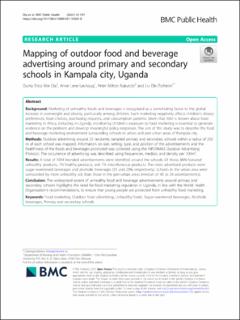| dc.contributor.author | Dia, Erica Wie | |
| dc.contributor.author | Løvhaug, Anne Lene | |
| dc.contributor.author | Rukundo, Peter Milton | |
| dc.contributor.author | Torheim, Liv Elin | |
| dc.coverage.spatial | Uganda, Kampala | en_US |
| dc.date.accessioned | 2021-09-17T12:07:15Z | |
| dc.date.available | 2021-09-17T12:07:15Z | |
| dc.date.created | 2021-04-13T16:18:47Z | |
| dc.date.issued | 2021-04-12 | |
| dc.identifier.citation | BMC Public Health. 2021, 21 . | en_US |
| dc.identifier.issn | 1471-2458 | |
| dc.identifier.uri | https://hdl.handle.net/11250/2778925 | |
| dc.description.abstract | Background: Marketing of unhealthy foods and beverages is recognized as a contributing factor to the global increase in overweight and obesity, particularly among children. Such marketing negatively affects children’s dietary preferences, food choices, purchasing requests, and consumption patterns. Given that little is known about food marketing in Africa, including in Uganda, monitoring children’s exposure to food marketing is essential to generate evidence on the problem and develop meaningful policy responses. The aim of this study was to describe the food and beverage marketing environment surrounding schools in urban and peri-urban areas of Kampala city. Methods: Outdoor advertising around 25 randomly sampled primary and secondary schools within a radius of 250 m of each school was mapped. Information on size, setting, type, and position of the advertisements and the healthiness of the foods and beverages promoted was collected using the INFORMAS Outdoor Advertising Protocol. The occurrence of advertising was described using frequencies, median, and density per 100m2. Results: A total of 1034 branded advertisements were identified around the schools. Of these, 86% featured unhealthy products, 7% healthy products, and 7% miscellaneous products. The most advertised products were sugar-sweetened beverages and alcoholic beverages (51 and 23%, respectively). Schools in the urban area were surrounded by more unhealthy ads than those in the peri-urban areas (median of 45 vs 24 advertisements). Conclusion: The widespread extent of unhealthy food and beverage advertisements around primary and secondary schools highlights the need for food marketing regulation in Uganda, in line with the World Health Organization’s recommendations, to ensure that young people are protected from unhealthy food marketing. | en_US |
| dc.description.sponsorship | This work received financial support by OsloMet – Oslo Metropolitan University. | en_US |
| dc.language.iso | eng | en_US |
| dc.publisher | BMC | en_US |
| dc.relation.ispartofseries | BMC Public Health;21, Article number: 707 (2021) | |
| dc.relation.uri | https://rdcu.be/cizXA | |
| dc.rights | Navngivelse 4.0 Internasjonal | * |
| dc.rights.uri | http://creativecommons.org/licenses/by/4.0/deed.no | * |
| dc.subject | Food marketing | en_US |
| dc.subject | Outdoor food advertising | en_US |
| dc.subject | Unhealthy foods | en_US |
| dc.subject | Sugar-sweetened beverages | en_US |
| dc.subject | Alcoholic beverages | en_US |
| dc.subject | Primary schools | en_US |
| dc.subject | Secondary schools | en_US |
| dc.title | Mapping of outdoor food and beverage advertising around primary and secondary schools in Kampala city, Uganda | en_US |
| dc.type | Peer reviewed | en_US |
| dc.type | Journal article | en_US |
| dc.description.version | publishedVersion | en_US |
| dc.rights.holder | © The Author(s). 2021 | en_US |
| dc.source.articlenumber | 707 | en_US |
| cristin.ispublished | true | |
| cristin.fulltext | original | |
| cristin.qualitycode | 1 | |
| dc.identifier.doi | https://doi.org/10.1186/s12889-021-10661-8 | |
| dc.identifier.cristin | 1903857 | |
| dc.source.journal | BMC Public Health | en_US |
| dc.source.volume | 21 | en_US |
| dc.source.pagenumber | 12 | en_US |

